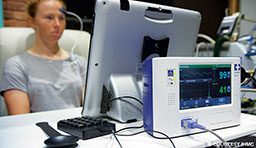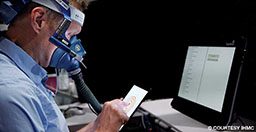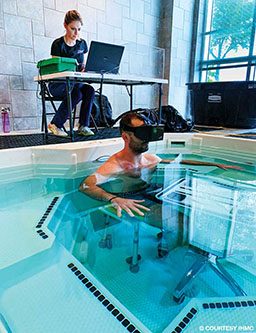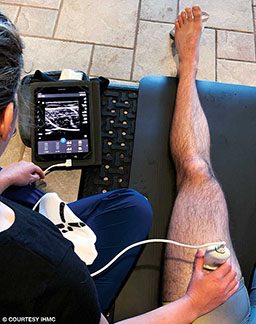Dawn Kernagis researches human performance in extreme environments.
A passionate cave diver and scientist, Dawn Kernagis, Ph.D., has been involved in numerous exploration projects since the 1990s, including as a crew member in the NASA Extreme Environment Mission Operations (NEEMO) 21 underwater habitat mission in 2016. The recipient of the 2018 Undersea and Hyperbaric Medical Society’s Young Scientist Award, she holds several other awards and distinctions.
Kernagis is a research scientist at the Institute for Human and Machine Cognition (IHMC) in Pensacola, Florida, and oversees the Human Health, Resilience and Performance research team. With funding from NASA and the Department of Defense, including the Office of Naval Research (ONR), she is leading several studies on human performance optimization and risk mitigation for operators in extreme environments.
What is your lab’s primary research focus?
Our lab focuses on looking at new ways to optimize performance for individuals who work in extreme environments. We look at performance from a whole perspective: physiological, physical and cognitive performance for divers, for people such as pilots and those in the mountains who work at altitudes, and for astronauts in space.
In what ways are these extreme environments — such as deep space and saturation diving — similar, and how are they different?

There are enough similarities across these environments that we can share knowledge from each of them, but there are also enough differences to study them separately. One common factor is the people we study. Compared with the general population, they are typically very healthy and often incredible athletes.
We watch individuals who are exceptionally healthy get pushed to their extreme because of the different stresses of the environments in which they work. We see impacts on the brain physiology and the cardiovascular system across all the different environments, which can ultimately affect cognitive and physical performance. While at altitude or diving, for example, subjects can develop hypoxia (not enough oxygen) or hypercapnia (too much carbon dioxide). Another similarity is that we see fluid shifts in the body in both microgravity and immersion. We also consider the psychological challenge. A lot of these exposures require subjects to be in isolation for an extended time and not able to access immediate medical treatment.
You mentioned that fluid shifts are different in diving, high altitudes and space. What are the differences?

We know different mechanisms are behind fluid shifts across the entire body in response to microgravity, and fluid shifts are also associated with diving and immersion. A loss of gravitational force causes one, and the impacts of cooling, wetness in the nostrils and hydrostatic pressure on the body cause the other. We are looking at the cardiovascular shift in these environments and the impact on the lymphatic system. It hasn’t been studied in any of these environments because science only recently had the tools to look at static flow. New imaging technologies will allow us to look at the lymphatic flow, which will be incredibly informative.
In diving and space research, we also generally work with healthy people including those in the military. How do you think the knowledge from these studies can translate to the recreational or technical diving communities?

You are right. We are not working with the average recreational diver, but there are pieces that we are studying in a generally healthy population that we can extrapolate to a relatively healthy recreational diving community. I like that in every study we are looking for solutions that have a direct user impact, both in the communities we are studying and in broader applications.
We are looking at nutritional applications that could protect divers from the cold, for example, or potential applications that could reduce the risk of central nervous system (CNS) oxygen toxicity — we still have a long way to go in this research. We are also looking at devices that can track changes in the diver’s body, especially in the eyes and eye movement, that could potentially detect hypoxia, hypercapnia or a potential impending CNS oxygen-toxicity seizure. Right now we lack alert systems, so we have no way to predict any of those changes or detect when they are happening.
Divers are looking for systems that will tell them that something is not quite right and that they might develop symptoms or be at risk if they don’t adjust their exposure. The eyes seem to be a good early window for this kind of detection, and this detection technology could apply to any diver.
Trying to measure hypercapnia in an underwater setting seems to be the holy grail of underwater experiments, but it hasn’t been very successful yet. If eye tracking is another way to look at this issue, could that technology become commercially available in the future?

The systems for this technology are still in the early stages of development and are undergoing dry testing at this point. If these tests are successful, it is feasible to start in-water testing in the next year or so. The time from testing the prototype to developing a commercially available device is a few years.
We do not focus on the commercialization of the devices; our main interest lies in developing a reliable tool for the research community to use to get a better understanding of conditions such as oxygen toxicity, fatigue, hypoxia and hypercapnia. This is just the beginning, but we hope to implement these types of detection or alert devices in the dive community within the next five to 10 years.
Who is on your team?
People with a variety of areas of expertise work in our lab or collaborate with us. My background is in neurophysiology and studying human physiology in extreme environments. We also have cognitive psychologists, physical performance specialists and experts in dive and space medicine. When studying nutritional strategies for coldwater divers, for example, we want to look at changes in core body temperature as well as positive or negative impacts on performance or other aspects of physiology with that nutritional strategy. Our team is able to look at the impact of potential approaches for resilience and performance from head to toe.
A lot of work is currently focusing on the ketogenic diet and supplementation strategies to prevent, for example, oxygen toxicity. Is your research going in the same direction?
Our team does not focus on the ketogenic diet itself. It is hard to maintain the diet and sustain ketosis (a physiological state in which ketone levels are over a certain threshold for a long time), and not everyone responds the same way to the diet. A reliable way to induce ketosis is by drinking ketone ester, which can quickly increase ketone levels. (Do not try this at home.) We are investigating if these elevated ketone levels can improve performance if consumed before exposure to extremely cold temperatures. Our team is also studying whether performance deficits improve with the consumption of ketones when individuals are subjected to hypoxia, which could be helpful for pilots and others working at altitude.

Where is your research headed next?
I am interested in neuroprotection and learning how to protect the brain when going to high-stress environments from extreme environments to the clinical setting. I am starting a few new studies to look at brain lymphatics and the effect of different environmental stresses on its function. How does elevated carbon dioxide impact fluid dynamics in the brain, for example, including the flow of blood and cerebral spinal fluid and lymphatic outflow?
How did you get into diving, and what made you become a dive scientist?
When I was young I wanted to learn how to dive. I got certified when I was 15, and my parents couldn’t get me out of a dive shop at that point. In high school I discovered cave diving and fell in love with it. I was fortunate to have parents who supported that passion.
While working on some cave diving projects in college, I was fortunate at a young age and early in my dive career to be mentored by some of the best cave divers in the world. I worked with them on a couple of other projects for about a decade and tried to figure out my next steps. I knew that I loved diving, but I wanted to have a bigger impact on the dive community in general, especially for the extreme divers I had met. I thought medicine was interesting, and I had lots of questions about what was physiologically happening to divers. Not many schools had programs like that, but I talked to David Doolette, Ph.D., and Dr. Richard Moon at Duke University and applied for funding from the ONR. We received the funding, which was the first time that ONR Undersea Medicine funded a project for a predoctoral opportunity. I made that project part of my doctoral studies, and that was the start of my current academic career.
What else do you want Alert Diver readers to know about you and your research?
I am excited that we are doing research that is end-user focused. We look for input from the dive community as well, and I am always open to talking to other divers and individuals about their experiences. Some medical issues and concerns come up in the dive community that the research community has not even thought of, which could lead to some interesting research. It’s important to have integration and communication between research scientists and divers so we can develop solutions together.
Explore More
Learn more about Dawn Kernagis and her work in these videos.
© Alert Diver — Q2 2020